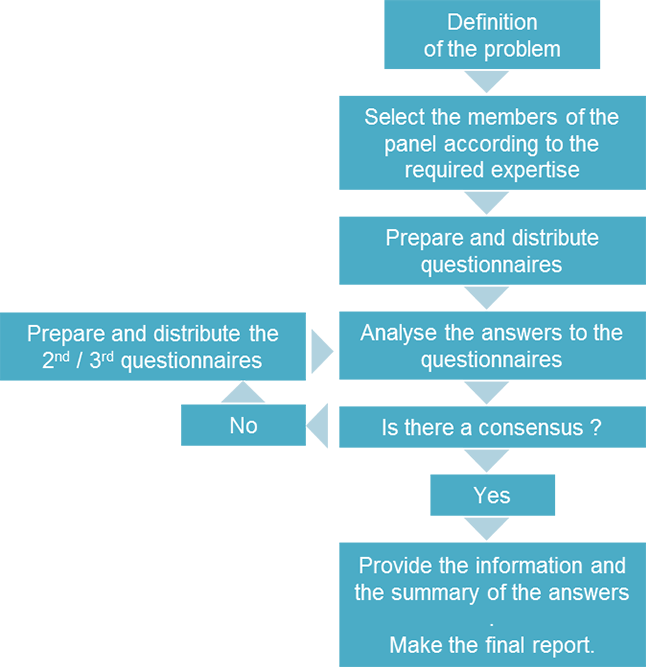4.3.4 DELPHI


Figure: for what phase this tool may be useful
The DELPHI method aims to highlight convergences of opinion and to identify some consensus on specific topics through the interrogation of experts, using successive questionnaires.
The “DELPHI” and “Régnier abacus” methods are presented separately but can be used simultaneously.
The RAND CORPORATION produced the DELPHI method in the 1950s originally to forecast the impact of technology on warfare.
The major objective of DELPHI studies is to collect experts’ opinions on a subject on which you have some uncertainties in order to help you to take a decision. By expert, we mean persons who have a good knowledge on the topics the DELPHI analysis is dealing with. Experts are also selected for their ability to envision the future. They have to be chosen according to these criteria.
The DELPHI method is not a questionnaire sent to a diverse audience but a questionnaire sent to a chosen panel.

Figure: the DELPHI steps
Questions should be specific and independent of each other (e.g. 20 questions divided into five themes). They must be relatively concise in their content and discuss only one topic.
Questionnaires (usually 3 to 4) are sent successively to identify a consensus. The method is interesting to use to collect at least 25 opinions. It is generally considered necessary to have a panel of 100 people in order to collect 25 answers. The questionnaires are sent by post or e-mail with a note explaining the goals, the spirit of DELPHI, and the practical conditions of the investigation (the response time should be specified and anonymity guaranteed). In order to increase the level of responses, experts can be contacted individually before sending them the first questionnaire in order to explain what is expected from them.
In the second round, the experts should be informed of the results of the first round before they provide their new answers in response. They are required especially to justify their opinions if they are very different from one of the majority of the group.
In the third round, each expert is asked to comment on the arguments of those with a different opinion. The fourth round gives the final answer: consensus opinion median and dispersion of opinions (interquartile ranges).
The questions are modified during the second and third rounds, depending on the responses obtained in the previous rounds (some deeper questions, new topics suggested by the experts at the end of their response etc.). It is important to have a question that identifies areas of questioning that had possibly not been covered previously.
Time: at least 1 month
Technical level: 3/4
Advantages: it is possible to obtain the opinion of each stakeholder not influenced by the group (no leader). It permits the generation of a consensus and the identification of deviations from the consensus, and explanations of this
Limits: time consuming; the need to conserve a high level interest of the panel so that the experts respond to each round
Resources needed: a questionnaire; postage costs or an email address or a website
Advice: it is important to limit the number of hypotheses so as not to be overwhelmed. It is possible to achieve a mini DELPHI in a shorter time as part of a workshop with the experts or stakeholders and discuss each question before answering

Example of implementation of a DELPHI: theoretical DELPHI experience build for a workshop held in Auray (France) in 2013. The example is dealing with a case study located in England and covers a coastal and marine area between Plymouth and Fowey (More information about the case study: ![]() ).
).
This DEPHI was not implemented on the territory. This example is also available in the scenario guideline [Herry and al., 2013].
More information:
DELPHI explained on the Encyclopaedia of business

